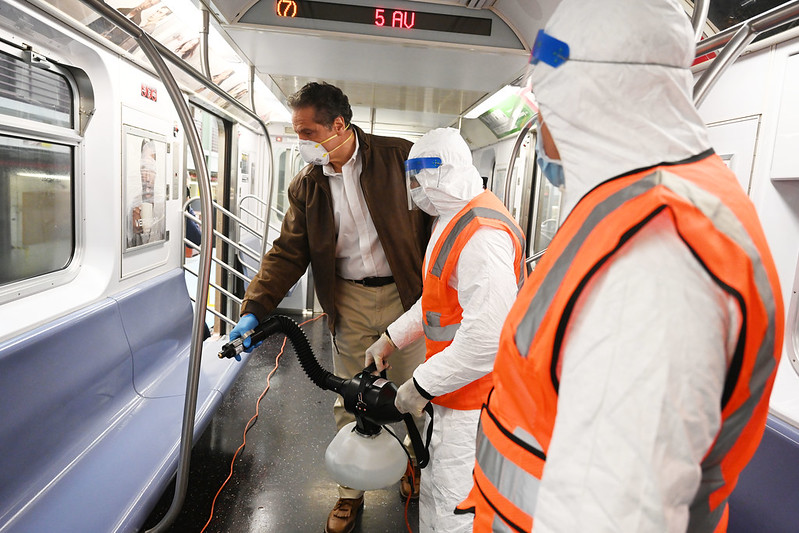
Governor Cuomo disinfects a subway car (photo: Kevin P. Coughlin/Governor's Office)
The subway is New York’s circulatory system. If it doesn’t recover, New York won’t. But reopening the subway and the city means more than running more trains: It also means helping homeless New Yorkers who today have nowhere else safe to go.
That is because, as Governor Cuomo demonstrated, the city’s transit crisis is too entwined with its housing crisis for the MTA alone to bring the subway back. In response to the rising number of New Yorkers with no choice but to seek shelter underground, the governor took the most dramatic step he’s taken since putting the state on pause: closing the subway system between 1 and 5 a.m. each night.
The end of 24-hour-a-day subway service made international headlines. In a cruel twist of irony, New York may no longer be the city that never sleeps and at the same time has one less place for unhoused people here to bed down. But closing the subway will not prevent people from sleeping in the transit system, so long as no other safe options are available. To date, the governor and Mayor de Blasio have refused to offer hotel rooms for homeless individuals on the streets or subways who need safe spaces to socially distance and take care of their basic human needs. Although the Mayor has touted that 1,000 people are being moved from congregate shelters to hotel rooms each week, thousands of homeless New Yorkers still face a heightened risk of contracting COVID-19 in congregate shelters -- and those on the streets and subways are not offered these hotel placements directly.
For several decades, as rents have risen, wages have not kept pace. In the past 15 years, New York City has lost more than a million low-rent units, and housing construction for extremely low-income and homeless households has not kept pace with that loss. That inequitable mismatch has increased the number of people who can’t afford a place to live, whether or not they work. Moreover, the shocking economic and health effects of the coronavirus pandemic have forced newly homeless people onto our streets and into the subways.
While New York City maintains a legal right to shelter, the congregate nature of many shelters is simply not safe, as evidenced by the spread of COVID-19 throughout approximately 171 shelters so far. Homeless New Yorkers on the subways know this and are consciously and reasonably refusing to enter shelters and risk their health.
At the same time, New York City needs 24-hour subway service. A significant number of riders -- many of them essential workers -- depend on the subway for travel between 1 and 5 a.m. and have no other option. Essential workers in health care, food service, building services, and more ride transit overnight while the rest of us sleep. Overnight subway service is essential to restore our 24-hour economy as soon as is safely possible. A full recovery is unimaginable without it.
Meanwhile, daytime service, which moved several million people daily for more than a century until March, will falter if crowding is unmanageable as New York reopens. As more New Yorkers return to work, the ability to maintain social distance on the commute is key. Governor Cuomo must ensure subway riders have more space than before. But to reliably limit crowding and keep both homeless and housed New Yorkers safe, he will also need to safely house people who have had to resort to sheltering inside subway cars.
The answer to homelessness in our transit system is not to drive people off the subway and further into the shadows, further from the help they so desperately need. The answer is to offer them safe temporary shelter and permanent housing. Right now, the city and state are deploying NYPD, MTA Police, and outreach workers to clear trains at night and offer “services.” These services are in the vast majority of cases a transport to an unsafe congregate shelter. Many individuals on the trains are aware of the risks of COVID-19 in shelters and take their chances on the streets instead.
City Council Speaker Corey Johnson and Council Member Stephen Levin recently proposed opening the city’s more than 100,000 empty hotel rooms to homeless people. This sensible option can provide the safe, private accommodations everyone needs to ride out the pandemic. With no indication when tourism will return, allowing homeless individuals on the streets and in the transit system to immediately access hotels is a creative, humane, and efficient way to match surplus with need. It is the right thing to do.
Similarly, state legislators led by Assemblymember Andrew Hevesi and Senator Liz Krueger have long advocated for state-funded housing vouchers to move people off streets, out of shelters and other public spaces, and into homes of their own. The Home Stability Support program and more permanent supportive housing would put state resources behind ending one of the harshest manifestations of life in the most unequal state in the nation.
In the coming weeks, these worthy proposals should form the basis of a housing plan fit for the subway that will keep riders safe. To reopen New York to everyone, around the clock, Governor Cuomo must seize the moment to meet New Yorkers’ housing needs.
***
Danny Pearlstein is Policy Director at the Riders Alliance. Giselle Routhier is Policy Director at Coalition for the Homeless. On Twitter @dannypearlstein & @RidersAlliance & @giselle_ashley & @nyhomeless.
***
Have an op-ed idea or submission for Gotham Gazette? Email This email address is being protected from spambots. You need JavaScript enabled to view it.




